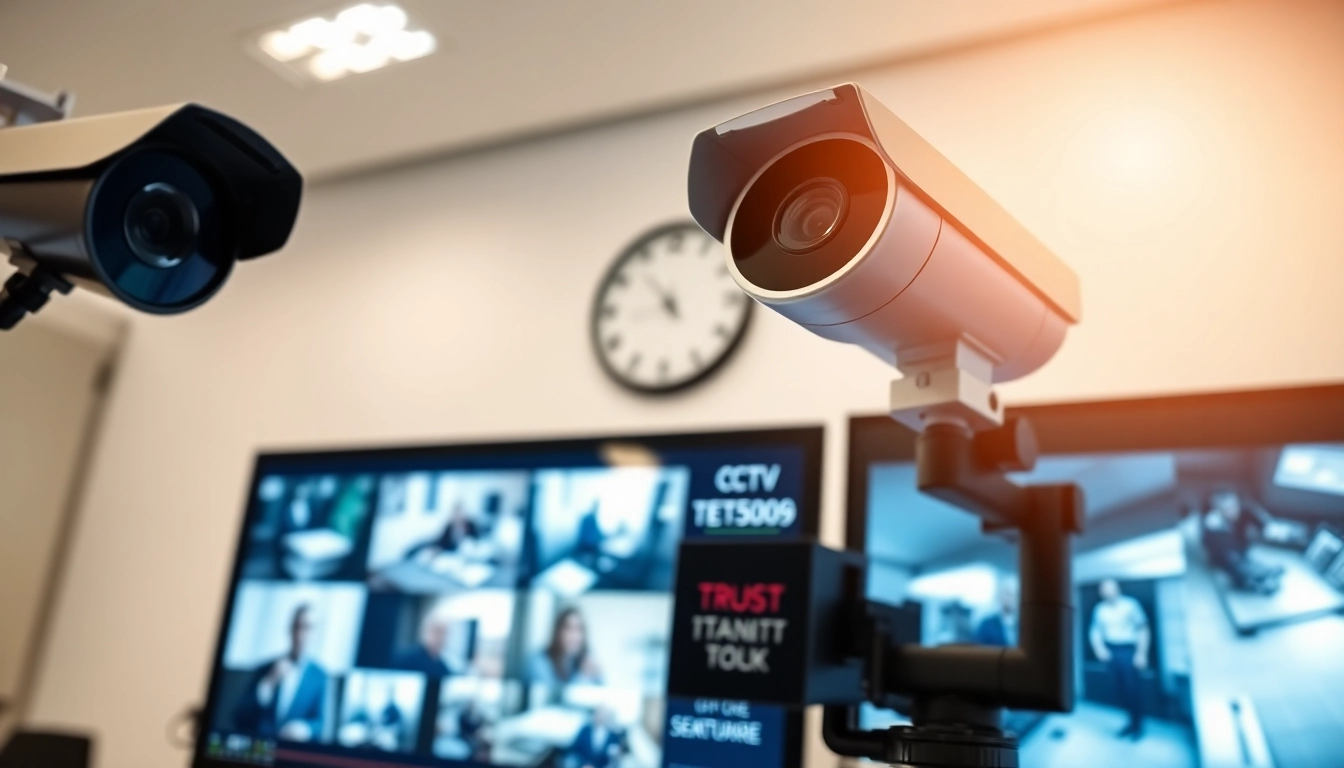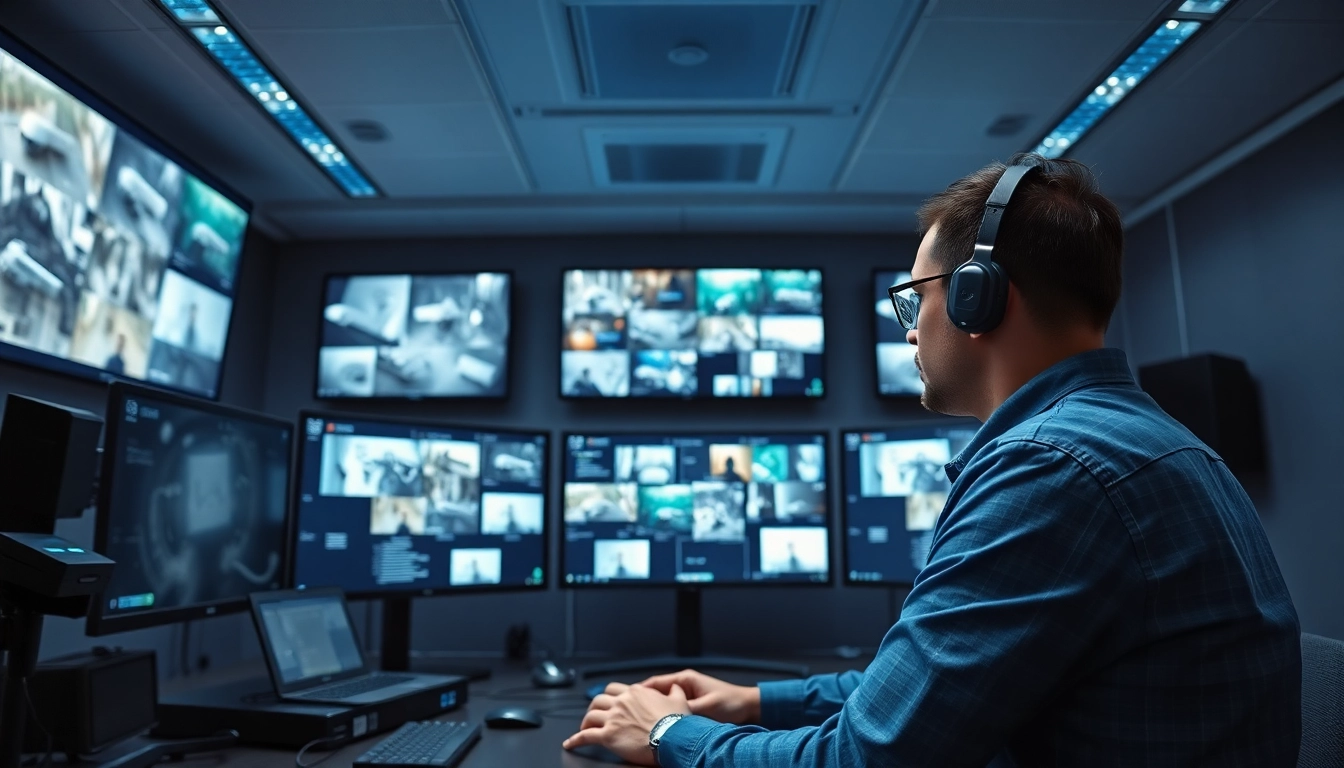Introduction to CCTV & Remote Monitoring
In today’s world, the demand for security solutions has surged, with organizations and individuals seeking effective ways to safeguard their properties and assets. One of the key technologies that has gained prominence in enhancing security measures is CCTV & Remote Monitoring. These systems not only provide surveillance but also offer real-time monitoring capabilities that can significantly improve security outcomes. This article delves into the essential aspects of CCTV and remote monitoring, exploring their definitions, histories, significance in security, components, installation considerations, best practices, and the impacts they have on overall security efficacy.
What is CCTV & Remote Monitoring?
CCTV, or Closed-Circuit Television, refers to a system of video cameras used to transmit a signal to a specific place, typically for surveillance and security purposes. Unlike broadcast television, the signal is not publicly distributed but is monitored at a private location. Remote monitoring involves the ability to view live feeds from CCTV cameras over the internet, allowing for surveillance from anywhere, at any time. Together, these technologies provide a robust framework for security, enabling property owners and security teams to monitor activities continuously.
History and Evolution of CCTV Technology
The history of CCTV dates back to the 1940s during World War II, when cameras were used to observe rocket launches in Germany. The concept of monitoring for security purposes evolved significantly over the following decades, with the first commercially available systems emerging in the 1960s. The introduction of video tape recorders in the 1970s allowed for recordings of surveillance footage, increasing the utility of CCTV systems. With advancements in technology, especially the development of digital video recording and IP camera technology in the early 2000s, CCTV systems became more efficient and accessible. The rise of the internet has facilitated the transition to remote monitoring, allowing users to access live feeds and recordings from anywhere in the world.
Importance of CCTV & Remote Monitoring in Security
The integration of CCTV and remote monitoring into security operations is vital for several reasons. Primarily, these systems deter potential criminals by increasing the perceived risk of being caught. Moreover, in the event of criminal activity or incidents, CCTV footage provides critical evidence that can aid in investigations and prosecutions. The ability to monitor premises remotely adds another layer of security, allowing for quick responses to incidents as they unfold. Furthermore, businesses and homeowners benefit from enhanced peace of mind, knowing they can keep a close eye on their properties from afar.
Key Components of CCTV & Remote Monitoring Systems
Cameras: Types and Features
The heart of any CCTV system lies in its cameras, which come in various types designed to serve particular purposes. Common types include:
- Dome Cameras: Known for their discreet design, they are often used in retail environments and public spaces.
- Bullet Cameras: Characterized by their elongated shape, these cameras provide a robust solution for outdoor surveillance.
- PTZ Cameras: With the ability to pan, tilt, and zoom, PTZ cameras are ideal for broad area monitoring.
- IP Cameras: These digital cameras connect to a network, offering higher resolutions and advanced features like remote access.
- Thermal Cameras: Designed to detect heat signatures, thermal cameras are crucial for low-light conditions and perimeter security.
Modern cameras also come equipped with features such as motion detection, wide dynamic range, and night vision, which enhance their effectiveness in various environments.
Monitoring Technology: Software and Hardware
Effective CCTV and remote monitoring systems consist not only of cameras but also of sophisticated monitoring software and hardware. The software allows users to view, record, and manage footage. Key features of monitoring software often include:
- Live Viewing: Users can view real-time footage from multiple cameras simultaneously.
- Digital Zoom: Users can focus on specific areas within the camera’s field of view without losing resolution.
- Alert Notifications: Customizable alerts can notify users of unusual activity based on predefined parameters.
- Video Analytics: Advanced systems feature analytics such as object detection, line crossing detection, and people counting.
In terms of hardware, a combination of servers for storage, monitors for viewing, and the necessary cabling or wireless connectivity is essential for a fully functional system.
Storage Solutions for Recorded Footage
Storage is a crucial aspect of CCTV and remote monitoring systems, as recorded footage needs to be safely stored and easily retrievable. Options include:
- Local Storage: This involves storing footage on-site using digital video recorders (DVRs) or network video recorders (NVRs). While local storage offers control, it can also be vulnerable to theft or damage.
- Cloud Storage: Cloud solutions provide a secure and scalable option for storing footage remotely, ensuring accessibility from anywhere while reducing the risk of data loss due to onsite incidents.
- Hybrid Solutions: Combining local and cloud storage, hybrid systems allow for the benefits of both methods, offering redundancy and enhanced data protection.
Installation Considerations for CCTV & Remote Monitoring
Site Assessment and Planning
Installing a CCTV and remote monitoring system begins with a comprehensive site assessment. This involves evaluating the area to determine the most effective locations for camera placement. Factors to consider include:
- Field of View: Identify critical areas that require surveillance, such as entrances, exits, and high-risk zones.
- Lighting Conditions: Assess the lighting in each area to select appropriate camera types (e.g., cameras suited for low-light conditions).
- Potential Obstacles: Consider physical obstructions that may interfere with camera angles and line-of-sight.
A well-planned installation that addresses these factors can significantly enhance the effectiveness of the CCTV and remote monitoring system.
Professional Installation vs. DIY
When it comes to installation, there are two primary options: professional installation and DIY. Each has its advantages and challenges:
- Professional Installation: Hiring experts can ensure that cameras are optimally placed and configured for maximum effectiveness. Professionals are familiar with various systems and can navigate any installation challenges. However, this comes at an increased cost.
- DIY Installation: For those with technical skills, DIY can be a cost-effective solution. Many modern systems are designed for easy installation, with user-friendly guides. However, improper installation may lead to suboptimal performance or coverage gaps.
Ultimately, the best choice depends on the individual’s budget, technical expertise, and the complexities involved in the installation site.
Regulatory Compliance and Permissions
Before installing CCTV systems, it is crucial to understand and comply with local laws and regulations concerning surveillance and privacy. Important considerations include:
- Data Protection Regulations: Ensure compliance with data protection laws, which typically govern how recorded footage may be used and stored.
- Notification Requirements: In many regions, signs indicating the presence of surveillance cameras are required to inform individuals they are being monitored.
- Secure Data Management: Establish protocols for data storage and access, ensuring that sensitive information is protected from unauthorized access.
Failure to comply with regulatory requirements can result in legal consequences and compromise the integrity of the security system.
Best Practices for CCTV & Remote Monitoring Usage
Effective Monitoring Strategies
To maximize the effectiveness of CCTV and remote monitoring systems, implementing best practices is essential. These strategies include:
- Regularly Reviewing Footage: Establishing a routine for reviewing recorded footage can help identify suspicious activity or operational issues.
- Setting Up Alerts: Utilize motion detection and alert features to receive notifications about unusual activity, enabling quicker responses.
- Creating a Monitoring Schedule: For organizations, designating staff to monitor feeds during critical hours can enhance surveillance.
Effective monitoring not only improves security but also helps maintain a proactive approach to potential threats.
Maintaining Privacy and Ethical Considerations
As valuable as CCTV and remote monitoring systems are, it is essential to address privacy and ethical concerns. Key considerations include:
- Balancing Security and Privacy: Ensure that surveillance measures do not infringe on personal privacy rights; cameras should focus on security areas without invading personal spaces.
- Transparent Policies: Establish clear policies about the use of CCTV and monitor access to recorded footage, ensuring transparency for employees and patrons.
- Limited Retention Periods: Set specific guidelines for how long footage will be stored and when it should be deleted to comply with data protection regulations.
By adhering to ethical practices, organizations can build trust and foster a security-friendly environment.
Regular Maintenance and System Checks
To ensure that CCTV and remote monitoring systems function optimally, regular maintenance is crucial. This includes:
- Routine Checks: Schedule periodic inspections to verify that all components, including cameras and storage devices, are operating correctly.
- Updating Software: Keep software and firmware up to date to mitigate security vulnerabilities and access new features.
- Clean Camera Lenses: Regularly cleaning camera lenses can prevent dirt and obstructions from affecting image quality.
Through consistent maintenance, users can extend the lifespan of their systems and maximize their investment in security technology.
Evaluating the Impact of CCTV & Remote Monitoring
Measuring Security Outcomes and Effectiveness
Evaluating the effectiveness of CCTV and remote monitoring systems is crucial for determining their value. Metrics to consider include:
- Incident Reduction: Analyzing crime rates before and after installation can provide insights into the deterrent effects of surveillance.
- Response Times: Monitoring response times to incidents can help assess the efficiency of the system in preventing or mitigating breaches.
- User Satisfaction: Gathering feedback from employees and patrons can indicate how well the system meets security expectations.
Ongoing analysis ensures that security measures remain effective and relevant to evolving threats.
Adapting to Emerging Security Challenges
The landscape of security threats is constantly changing, necessitating that CCTV and remote monitoring systems adapt accordingly. Strategies for adaptation include:
- Leveraging New Technologies: Keep abreast of advancements in AI and machine learning, which can enhance video analytics and threat detection capabilities.
- Flexible System Designs: Choose systems that can easily incorporate new technologies or expand coverage areas as needed.
- Continuous Training: Ensure that security personnel are continually trained on new technologies and threat response strategies.
By proactively addressing emerging challenges, organizations can maintain robust security measures.
Case Studies: Successful Implementations
Examining successful case studies can offer valuable insights into the practical impacts of CCTV and remote monitoring systems:
- Retail Security: A chain of retail stores implemented a CCTV system that resulted in a reported 30% decrease in theft and inventory loss, as well as a more secure shopping environment for customers.
- Campus Safety: A university enhanced campus safety with a comprehensive CCTV installation, leading to quicker emergency responses and improved student feedback regarding feelings of safety.
- Commercial Property: A business park reduced vandalism incidents by 50% after integrating remote monitoring solutions, providing real-time surveillance and immediate alerts to security personnel.
These cases illustrate the tangible benefits and effectiveness that well-executed implementations of CCTV and remote monitoring can achieve.




